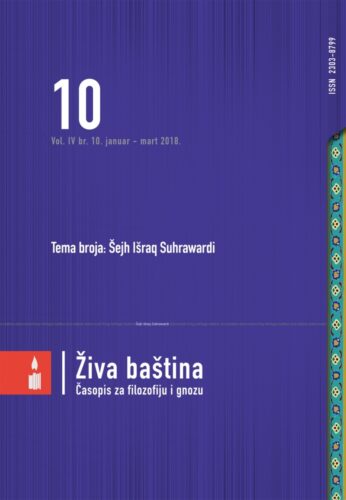UDK 821.222.1.09 Shirazi
U sveukupnoj povijesti muslimanskog mišljenja klasična perzijska poezija bila je ta koja je već od ranijih vremena položila temelje onoj duhovnoj pojavi u mislećoj tradiciji islama danas znanoj kao “religija ljubavi”. Motrena u svjetlu duhovnih činjenica uzetih iz sveobuhvatnog sadržaja primarnih vrela islama: Kur’ana i hadīsa, “religija ljubavi” jednostavno se nadaje kao istinska vjera u pogledu Božijem od predvječnosti do postvječnosti, posebice u kazivanjima o činu Božijeg stvaranja svijeta i krunskog Božijeg stvorenja u njemu – čovjeka. U dvanaestom i trinaestom stoljeću javljaju se glasonoše “religije ljubavi” u muslimanskome mišljenju, kao što su Nizāmi iz Ganja (umro 598/1202), ‘Attār iz Nishapura (umro 1221 ili 1229), Muhyiddīn ibn ‘Arabī (umro 1240), ‘Umar ibn Fārid (umro 1235), koji su na temeljima “religije ljubav” podizali duhovni hram, a njegovoj gradnji će u tom razdoblju ponajviše doprinijeti Jalāl al-Dīn Rūmī (umro 1273), Sā’dī (umro oko 1283) i Hāfiz Širazi (1389). Hāfiz iz Shirāza ubraja se među najveće i, vjerovatno, posljednje promicatelje ovog duhovnog fenomena unutar perzijske književnost. U svojoj teoriji o religiji Ljubavi on, između ostalog, naučava da i ljudska bića i duhovi crpe svoju snagu uzdržavanja iz Ljubavi koja, kao Atribut Božiji, iz praiskona potiče Imena Božija da nepretrgnuto prelaze iz stanja zamišljenih odnosa (nusub dhihniya) u stanje egzistencijalnog ozbiljenja (in actu).
Ključne riječi: religija Ljubavi, Hafiz Širazi, sufijska poezija, perzijska poezija
Abstract
The Idea of the Religion of Love in the Poetry of Hafiz Shirazi
Rešid Hafizović
In the entire history of Muslim thought, from the earliest times, it was the classical Persian poetry that laid the foundation of the spiritual phenomenon in the thinking tradition of Islam which is today known as “the religion of love”. Observed in light of the spiritual facts from the comprehensive content of the primary sources of Islam: Qur’an and hadiths, “the religion of love” is presented as the true faith in God’s sight from the pre-eternity to post-eternity, in particular in the narratives about the act of God’s creation of the world and the crucial being in it – man. In the 12th and 13th century, the heralds of “the religion of love” appeared in the Muslim thought, such as Nizāmi from Ganj (died in 598/1202) , ‘Attār from Nishapur (died in 1221 or 1229), Muhyiddīn ibn ‘Arabī (died in 1240), ‘Umar ibn Fārid (died in 1235), who have built a spiritual temple on the foundations of “the religion of love”, while the persons who have mostly contributed to its construction were Jalāl al-Dīn Rūmī (died in 1273), Sā’dī (died around 1283) and Hāfiz Širazi (1389). Hāfiz from Shirāz belongs among the greatest and probably the last promoters of this spiritual phenomenon in Persian literature. In his theory of “the religion of love”, he maintains that, among others, humans and spirits draw their strength of existence from Love, which, as an attribute of God, from the primordial time, initiates God’s Names to move uninterruptedly from the state of imagined relations (nusub dhihniya) into the state of existential manifestation (in actu).
Keywords: the religion of love, Hafiz Shirazi, Sufi poetry, Persian poetry
[tags]

